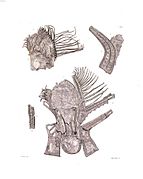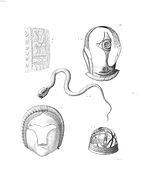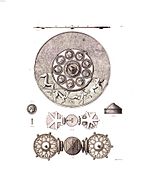Thorsberger Moor
The Thorsberger Moor ( Danish : Torsbjerg Mose ) is a moor in the northern municipality of Süderbrarup in the fishing region in Schleswig-Holstein . This inconspicuous body of water is an important archaeological site and Germanic sacrificial moor from the Roman Empire . Numerous significant and rich cultural and historical discoveries were made in the moor in the 19th century.
Surname
The name does not allow the assumption that the sanctuary was exclusively dedicated to the god Donar / Thor at the time of the Angling . Rather, the naming is based on early medieval Danish influence, especially in the Viking Age , when the moor was no longer covered with offerings. In addition, when most of the fishing rods moved to the British Isles, there was a disruption of settlement and culture. That the early medieval (Danish) settlers worshiped Thor ( Thorsmoor ) is possible, but not proven. The name of the moor is therefore more reliably attributed to a hill lying to the south with a Viking Age burial ground and finds, the Thorsberg . In the "Süderbrarupschen Erdbuch " from the 17th century, the place is occupied as Taßberg, Toßberg , with the southern Jut dialectal shrinkage of the r , which is derived from the Danish form T (h) orsbjerg . The land north of the moor is recorded as the eighth de Torsmoor in the earth book . Since the excavation by Conrad Engelhardt in the 19th century and his publications, the moor has been referred to as the Thorsberger Moor in research .
Historical background
In the period from the 1st century BC BC to the early 5th century AD, objects were sacrificed in several phases in the Thorsberger Moor, presumably by members of the West Germanic Angles tribe.
The reason for the particularly large number of weapon victims from the 3rd and 4th centuries AD was assumed by research that it was booty from internal Germanic conflicts, on the one hand from conflicts between the native Germanic peoples and warriors from the "Free" Germania ( Germania magna ) in direct or indirect proximity to the Rhenish contact zone and the border with the Roman Empire and, on the other hand, with North Germanic ethnic groups, from the southern Scandinavian coastal regions and island areas. The assumed conflicts are possibly related to the great migration of the peoples of late antiquity , perhaps as an expression of distribution struggles and processes of ethnic transformation. It is unclear whether the sacrificed weapons were taken from invaders fought off, as older research mostly assumed, or whether they are rather pieces that were taken by victorious warriors after raids in southern Scandinavia, in the areas on the upper reaches of the Elbe and in the edge zone of the Imperium Romanum were transferred to their homeland and then (partially?) Sacrificed at Thorsberg.
Archaeological development
The Thorsberger Moor is centrally located in the "Süderbraruper Siedlungskammer" as the starting point for the Iron Age settlement of East Schleswig. It is surrounded by older geological evidence such as numerous Bronze Age burial mounds , which are almost completely leveled today by the plowing, to the early medieval, Viking Age settlement traces and burial fields. The approximately 140 × 300 m large Kesselmoor is today mostly archaeologically disturbed by the peat extraction and is characterized by a shallow pond , which silts up in a boggy way towards the unspoiled southwestern end. The former state at the time of the sacrificial activities is uncertain, but research generally assumes that the moor was characterized by drier zones and humid depressions in which the sacrifices were made.
After initial finds during peat cutting in the 1850s and after initial preliminary investigations by the Flensburg teacher, curator and archaeologist Helvig Conrad Engelhardt (1825–1881), he systematically dug the sacrificial site in the spring of 1858 and in two further campaigns in 1860 and 1861 in the eastern area of the moor out; according to his excavation sketches and notes, essentially in the area of today's marshy island overgrown with bushes.
The actual sacrificial site in the moor was in a relatively small, deep and relatively dry basin with an area of around 750 m² at a distance of 10 to 20 m from the bank. The site was once ritually enclosed with a rod fence, and a bridge led from the southern bank to the place where the victims were deposited. The posts were driven deep into the ground and covered with sticks and sticks. The layer that contained the finds was 1.5 to 1.8 m thick, the finds were usually scattered over the area, and a systematic, more orderly deposit was discernible in individual places. Shield boards, for example, were bundled in layers, Roman coins and gold finds were each more concentrated together.
Engelhardt documented the excavation and finds in an exemplary manner for the time. The Danish archaeologist Jens Jacob Asmussen Worsaae was the first researcher in 1865 to address the finds as victims of war booty.
According to Engelhardt, the “Flensburger Altertumsgesellschaft” excavated the site in 1885 in a two-week campaign with an excavator; the results of the find were manageable and the action was not adequately documented. Ten years later, in 1895, the “Anthropological Association in Schleswig-Holstein” attempted a campaign from August 3 to September 14 without any noteworthy findings. As a result of these amateur excavations that followed Engelhardt, the site was so destroyed that it is no longer possible to identify the original Engelhardt excavations and to grasp them spatially. A prospecting in 1997 on the eastern edge revealed only a few fragments of wooden objects.
Some of the most important finds from the excavations are shown in the Schleswig-Holstein State Museum at Gottorf Castle in Schleswig and in the Danish National Museum in Copenhagen . However, most of the items are in German and Danish magazines and are currently not accessible to the public. The finds are located next to the museums in Copenhagen and Schleswig in Flensburg ( Museumsberg Flensburg - municipal museums and collection for the Schleswig part of the country), in Hamburg ( Archaeological Museum Hamburg ) and in Berlin ( Museum for Prehistory and Early History , National Museums in Berlin - Prussian cultural property). These finds were almost completely re-cataloged in 1987 by Klaus Raddatz .
Finds
Thorsberg trousers , 4th century
The outstanding finds include a Germanic face mask made of silver (formerly part of a two-part helmet based on the Roman model), textile items of clothing such as gorgeous coats , smocks and trousers, calf wraps , Roman helmets and coins along with a chain mail and rune-inscribed items. The conservation conditions for organic material were optimal in this moor, whereas most of the iron tools , especially since the numerous (mostly Roman) swords, were largely chemically destroyed. Due to the extraordinarily good preservation conditions, the relatively good documentation of the excavations and the large amount of objects found, the Thorsberger Moor, along with Nydam , Illerup Ådal and Vimose (all three in Denmark ), is one of the most important sites of this time in Northern Europe. The finds show how far Roman influence extended beyond the borders of the empire.
The oldest finds come from the Stone and Bronze Ages . In the middle of the Latène period (LT B) , the dumping of clay ceramics began, the presumable content of which consisted in part of food offerings that have not been preserved, or traces of them. The core period of these filings is for the time from 100 BC. u. Z. to 300 n. A. Z. dated. The finds from this time testify to a peaceful, rural culture of the dedicants , as shown by comparable bog finds in other places in northern Germany and Denmark. The nature of the sacrifice changed at the beginning of the 2nd century. The number of high-quality metal objects such as brooches, belt fittings, jewelry made of noble metals (gold, silver, bronze) and, increasingly, weapons and armor parts is increasing in the shift. The core period for this layer is dated to the 2nd and 3rd centuries. The vast majority of weapon victims appear in the find horizon of the 3rd and 4th centuries with the striking feature that they were often either rendered cultically unusable before the sacrifice or damaged in the course of fighting. The more recent research assumes that the filing took place in larger complexes contrary to earlier assumptions about filing over longer periods of time.
Runic inscriptions

The objects marked with runes were found during Engelhardt's excavation campaigns. The bearers of the inscriptions are entirely weapon parts from scattered finds:
- Sword grip
- Ortband
- Shield boss
Another shield boss of Roman origin made of bronze bears the hallmarked Latin owner's inscription AEL (ius) AELIANUS. The piece probably got to "Thorsberg" as booty.
Sword fitting
Cuff- shaped grip of a sword hilt from the first half of the 3rd century, which is made with two edge pieces, one of which bears a rune inscription. The pointed oval fitting part (height: 2.3 cm) shows four square upper and four narrower lower fields, which are separated from each other by tremolating stitches. In the upper part (height: 1.3 cm) there are two adjacent fields with rune-like characters or stylized swastics . The fitting belongs to a splendid sword that is assigned to a follower leader who, after the spread of the type, presumably led an attacking army from the area between the Rhine and Elbe. The piece is in the depot of the National Museum in Copenhagen (Inv.-No. 24 963).
The quality of the characters as runes is assessed differently in research. Wolfgang Krause interprets the signs as runes; Klaus Düwel as at best a rune-like decorative sign.
- Two characters: ᛟᛟ
- Transliteration: ō ō
- Transfer: "inheritance, inheritance"
Ortband
The bronze chape with breakthrough work on a pelte-like basic shape from Roman manufacture, 2nd / 3rd century . Century, at the upper end of a non-preserved sword scabbard made of wood / leather (5.12 × 4.7 cm). The piece is kept in the Archaeological State Museum Schleswig (Inv.No. FS 5767).
The inscriptions (KJ 20; DR 7) are clearly legible on both cover plates to the right. The e and m runes (rune no. 6 [6, 7]) of the inscription B are made as tie runes (em).
- A: ᛟᚹᛚᚦᚢᚦᛖᚹᚨᛉ
- B: ᚾᛁᚹᚨᛃᛖᛗᚱᛁᛉ
- Transliteration: ō W [u] lþuþewaz / R ni Wajemāriz / R
- Transfer: "Hereditary property - Wulþuþewaʀ (= Ull servant), who is not badly famous"
Shield boss
A bronze shield boss (outer diameter: approx. 16.5 cm; rim width: 2.1 cm) from the first half of the 3rd century, which was ritually damaged for the sacrifice. The left-hand runic inscription (KJ21; DR8) can be found on the invisible edge of the hump in the space between two fastening nails. The piece is kept in the Archaeological State Museum Schleswig (Inv.No. FS 3262).
The runes are carved with a height of 2.1 cm. It is unclear whether the runes were scratched before the sacrifice or after the cultic destruction or for the sacrifice ceremony.
- ᚺᛉᚷᛊᛁᚨ
- Transliteration: aisgz / R h
- Transmission: "Aisigaʀ (= the madman, the storming one, the angry one) - hail / ruin"
Findings from the excavations in 1858–1861
literature
- Claus von Carnap-Bornheim , Eva Nyman : Thorsberg (naming, archaeological). In: Reallexikon der Germanischen Altertumskunde (RGA). 2nd Edition. Volume 35, Walter de Gruyter, Berlin / New York 2007, ISBN 978-3-11-018784-7 , pp. 123-127. ( Fee Germanic Alterumskunde online at de Gruyter )
- Claus von Carnap-Bornheim (Ed.): The Thorsberger Moor. Association for the Promotion of the Archaeological State Museum eV, Gottorf Castle, Schleswig 2014–2015. In this:
- Nina Lau: The Thorsberger Moor, Volume 1. The harness. Germanic bridles and harnesses as evidence of warlike cavalry in the Central and Northern European Barbaricum. Schleswig 2014, ISBN 978-3-00-046354-9 .
- Ruth Blankenfeldt: The Thorsberger Moor, Volume 2. The personal equipment. Schleswig 2015, ISBN 978-3-00-049372-0 .
- Suzana Matešič: The Thorsberger Moor, Volume 3. The military equipment. Comparative studies on Roman and Germanic armament. Schleswig 2015, ISBN 978-3-00-051555-2 .
- The Thorsberger Moor, Volume 4. History of finds and research, scientific and material studies. With contributions by Ruth Blankenfeldt, Claus von Carnap-Bornheim, Walter Dörfler, Julia Gräf, Klemens Kelm, Nina Lau, Suzana Matešić and a reprint by Conrad Engelhardt (1825–1881). Schleswig 2014, ISBN 978-3-00-046355-6 .
- Klaus Düwel : Thorsberg (runological). In: Reallexikon der Germanischen Altertumskunde (RGA). 2nd Edition. Volume 30, Walter de Gruyter, Berlin / New York 2005, ISBN 3-11-018385-4 , pp. 485-487. ( Fee Germanic Alterumskunde online by de Gruyter)
- Matthias Egeler: Germanic cult places in Germany. I - 23.6. In: Michael Klöcker , Udo Tworuschka (Hrsg.): Handbuch der Religionen. Issue 43, OLZOG Verlag GmbH, Munich 2015.
- Helvig Conrad Engelhardt : Thorsberg Mosefund. Sønderjyske Mosefund I. Thorsbjerg fundet. Kjöbenhavn 1863. ( digitized version )
- Michael Fee , Claus von Carnap-Bornheim: Nydam and Thorsberg. Iron Age sacrificial sites; Booklet accompanying the exhibition. Archaeological State Museum, Association for the Promotion of the Archaeological State Museum e. V., Gottorf Castle, Schleswig 2000.
- Oliver Grimm, Alexandra Pesch (ed.): Archeology and runes. Case studies of inscriptions in the older Futhark. Contributions to the workshop at the Center for Baltic and Scandinavian Archeology (ZBSA) in Schleswig on 3./4. February 2011. (= Writings of the Archaeological State Museum - supplementary series, Volume 11). Wachholtz Verlag - Murmann Publishers, Kiel / Hamburg; Center for Baltic and Scandinavian Archeology in the Schleswig-Holstein State Museums Foundation Gottorf Castle / Schleswig 2015, ISBN 978-3-529-01881-7 . In this:
- Andreas Rau: Archaeological research on the sacrifices of army equipment and determination of the origin of finds with particular reference to rune-inscribed objects. Pp. 29-43.
- Ruth Blankenfeldt: The origin of the Germanic fund groups from the Thorsberger Moor. Pp. 59-77.
- Suzana Matešić: Roman militaria from the Thorsberger Moor - compilation and provenance. Pp. 79-89.
- Suzana Matešić: Runic inscriptions and runic-like items from the Thorsberger Moor - New archaeological and material studies. Pp. 91-99.
- Jana Krüger: On the possibilities of determining the provenance of the runic inscriptions by Thorsberg. Pp. 101-108.
- Lisbeth M. Imer: The inscriptions from Thorsberg - Germanic inscription making as a reflection of Roman writing. Pp. 109-115.
- Herbert Jankuhn : Nydam and Thorsberg. Iron Age bog finds. (= Guide through the collection of the Schleswig-Holstein State Museum for Prehistory and Early History in Schleswig, Volume 3). New edition Wachholtz Verlag, Neumünster 1987, ISBN 3-529-01603-9 .
- Wolfgang Laur : Germanic sanctuaries and religion in the mirror of the place names Schleswig-Holstein, northern Lower Saxony and Denmark. (= Kiel contributions to the history of German language, Volume 21) .Wachholtz, Neumünster 2001, ISBN 978-3-529-04371-0 .
- Michael Müller-Wille : sacrificial cults of the Teutons and Slavs. Konrad Theiss Verlag, Stuttgart 1999, ISBN 3-8062-1443-3 .
- Klaus Raddatz : The Thorsberger Moorfund catalog. Parts of weapons and harness, other found objects of metal and glass, clay and wooden vessels, stone tools (Offa books; vol. 65). Wachholtz Verlag, Neumünster 1987, ISBN 3-529-01165-7 .
- Klaus Raddatz: The Thorsberg Moor Find. Belt parts u. Body jewelry (prehistory and early historical studies from the Schleswig-Holstein State Museum for Prehistory and Early History in Schleswig / NS; vol. 13). Wachholtz Verlag, Neumünster 1957.
- Andreas Rau, Claus von Carnap-Bornheim: The Imperial Army Equipment Victims of Southern Scandinavia - Considerations on Key Finds of Archaeological-Historical Interpretation Patterns in Imperial Archeology. In: Heinrich Beck et al. (Hrsg.): Classical Studies - Classical Studies - Cultural Studies: Income and Perspectives after 40 Years Real Lexicon of Germanic Classical Studies. (= Reallexikon der Germanischen Altertumskunde - supplementary volumes , volume 77). Walter de Gruyter, Berlin / Boston 2012, ISBN 978-3-11-027360-1 , pp. 515-540.
Web links
- State Museum Schloss Gottorf - Nydam and Thorsberg.
- Runic project of the University of Kiel
- thorsberger-moor.de (private website with solid information)
Remarks
- ↑ Wolfgang Laur: Germanic sanctuaries and religion in the mirror of the place names Schleswig-Holstein, northern Lower Saxony and Denmark. Neumünster 2001, pp. 74f., 146ff.
- ↑ Ruth Blankenfeldt: In the footsteps of Conrad Engelhardt. Where were the excavations in Thorsberger Moor? In: Sunhild Kleingärtner, Lilian Matthes, Mette Nielsen (eds.): Arkælogi i Slesvig / Archeology in Schleswig, Volume 12, 2008, pp. 79–90.
- ↑ Profile Runenprojekt Kiel with references.
- ↑ Wolfgang Krause, Herbert Jankuhn: The runic inscriptions in the older Futhark. V&R, Göttingen 1966, No. 20 Notes, p. 55.
- ↑ Klaus Düwel: Runic inscriptions on weapons. In: Ruth Schmidt-Wiegand (Ed.): Words and things in the light of designation research. (= Work on early medieval research, volume 1). Walter de Gruyter, Berlin / New York 1981, ISBN 978-3-11-086161-7 , pp. 128-167; here 137.
- ^ Klaus Düwel: Runenkunde. 4th edition, Metzler, Stuttgart 2008, p. 10.
Coordinates: 54 ° 38 ′ 32.2 " N , 9 ° 46 ′ 18.8" E





























